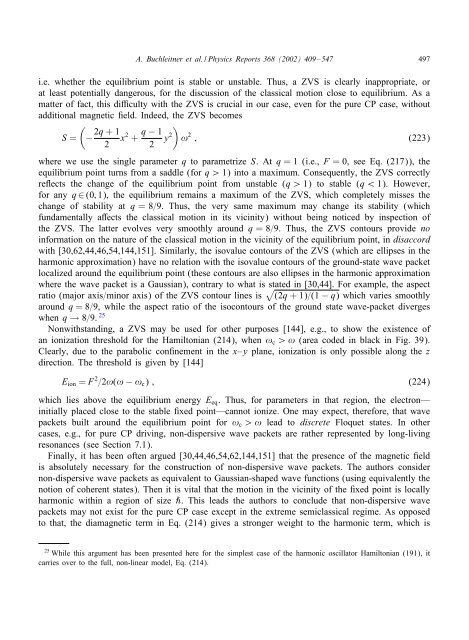Non-dispersive wave packets in periodically driven quantum systems
Non-dispersive wave packets in periodically driven quantum systems
Non-dispersive wave packets in periodically driven quantum systems
Create successful ePaper yourself
Turn your PDF publications into a flip-book with our unique Google optimized e-Paper software.
A. Buchleitner et al. / Physics Reports 368 (2002) 409–547 497<br />
i.e. whether the equilibrium po<strong>in</strong>t is stable or unstable. Thus, a ZVS is clearly <strong>in</strong>appropriate, or<br />
at least potentially dangerous, for the discussion of the classical motion close to equilibrium. As a<br />
matter of fact, this di culty with the ZVS is crucial <strong>in</strong> our case, even for the pure CP case, without<br />
additional magnetic eld. Indeed, the ZVS becomes<br />
<br />
2q +1<br />
S = − x<br />
2<br />
2 q − 1<br />
+<br />
2 y2<br />
<br />
! 2 ; (223)<br />
where we use the s<strong>in</strong>gle parameter q to parametrize S. Atq = 1 (i.e., F = 0, see Eq. (217)), the<br />
equilibrium po<strong>in</strong>t turns from a saddle (for q¿1) <strong>in</strong>to a maximum. Consequently, the ZVS correctly<br />
re ects the change of the equilibrium po<strong>in</strong>t from unstable (q¿1) to stable (q¡1). However,<br />
for any q ∈ (0; 1), the equilibrium rema<strong>in</strong>s a maximum of the ZVS, which completely misses the<br />
change of stability at q =8=9. Thus, the very same maximum may change its stability (which<br />
fundamentally a ects the classical motion <strong>in</strong> its vic<strong>in</strong>ity) without be<strong>in</strong>g noticed by <strong>in</strong>spection of<br />
the ZVS. The latter evolves very smoothly around q =8=9. Thus, the ZVS contours provide no<br />
<strong>in</strong>formation on the nature of the classical motion <strong>in</strong> the vic<strong>in</strong>ity of the equilibrium po<strong>in</strong>t, <strong>in</strong> disaccord<br />
with [30,62,44,46,54,144,151]. Similarly, the isovalue contours of the ZVS (which are ellipses <strong>in</strong> the<br />
harmonic approximation) have no relation with the isovalue contours of the ground-state <strong>wave</strong> packet<br />
localized around the equilibrium po<strong>in</strong>t (these contours are also ellipses <strong>in</strong> the harmonic approximation<br />
where the <strong>wave</strong> packet is a Gaussian), contrary to what is stated <strong>in</strong> [30,44]. For example, the aspect<br />
ratio (major axis=m<strong>in</strong>or axis) of the ZVS contour l<strong>in</strong>es is (2q +1)=(1 − q) which varies smoothly<br />
around q =8=9, while the aspect ratio of the isocontours of the ground state <strong>wave</strong>-packet diverges<br />
when q → 8=9. 25<br />
<strong>Non</strong>withstand<strong>in</strong>g, a ZVS may be used for other purposes [144], e.g., to show the existence of<br />
an ionization threshold for the Hamiltonian (214), when !c ¿! (area coded <strong>in</strong> black <strong>in</strong> Fig. 39).<br />
Clearly, due to the parabolic con nement <strong>in</strong> the x–y plane, ionization is only possible along the z<br />
direction. The threshold is given by [144]<br />
Eion = F 2 =2!(! − !c) ; (224)<br />
which lies above the equilibrium energy Eeq. Thus, for parameters <strong>in</strong> that region, the electron—<br />
<strong>in</strong>itially placed close to the stable xed po<strong>in</strong>t—cannot ionize. One may expect, therefore, that <strong>wave</strong><br />
<strong>packets</strong> built around the equilibrium po<strong>in</strong>t for !c ¿! lead to discrete Floquet states. In other<br />
cases, e.g., for pure CP driv<strong>in</strong>g, non-<strong>dispersive</strong> <strong>wave</strong> <strong>packets</strong> are rather represented by long-liv<strong>in</strong>g<br />
resonances (see Section 7.1).<br />
F<strong>in</strong>ally, it has been often argued [30,44,46,54,62,144,151] that the presence of the magnetic eld<br />
is absolutely necessary for the construction of non-<strong>dispersive</strong> <strong>wave</strong> <strong>packets</strong>. The authors consider<br />
non-<strong>dispersive</strong> <strong>wave</strong> <strong>packets</strong> as equivalent to Gaussian-shaped <strong>wave</strong> functions (us<strong>in</strong>g equivalently the<br />
notion of coherent states). Then it is vital that the motion <strong>in</strong> the vic<strong>in</strong>ity of the xed po<strong>in</strong>t is locally<br />
harmonic with<strong>in</strong> a region of size ˝. This leads the authors to conclude that non-<strong>dispersive</strong> <strong>wave</strong><br />
<strong>packets</strong> may not exist for the pure CP case except <strong>in</strong> the extreme semiclassical regime. As opposed<br />
to that, the diamagnetic term <strong>in</strong> Eq. (214) gives a stronger weight to the harmonic term, which is<br />
25<br />
While this argument has been presented here for the simplest case of the harmonic oscillator Hamiltonian (191), it<br />
carries over to the full, non-l<strong>in</strong>ear model, Eq. (214).











